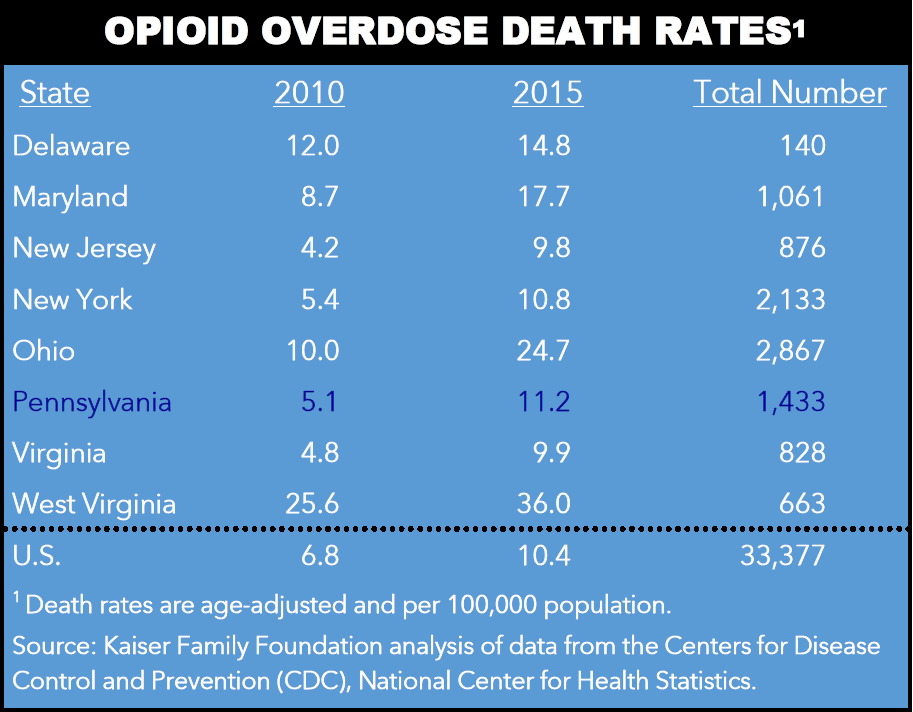August 2017
September 01, 2017 | Revenue & Economic Update

The origins of the national opioid crisis can be traced to the late 1990s, when patients suffering from chronic pain received opioid prescriptions at a greatly accelerated rate. The misuse of those drugs and, as later discovered, their highly addictive nature, produced the current opioid crisis. For 2015, data from the Centers for Disease Control (CDC) show that Pennsylvania’s rate of opioid drug overdose deaths ranked 18th in the nation. In addition to significant personal costs, the crisis also has implications for state and local budgets and economies.
The opioid overdose death rate (rate per 100,000 in population) has increased dramatically. (See table.) In 2015, Pennsylvania’s opioid overdose death rate was 11.2, up from 5.1 in 2010, a growth rate of 120 percent. The data imply that 1,433 Pennsylvania residents died from opioid overdoses in 2015, compared to 652 in 2010.
In July, the Drug Enforcement Agency (DEA) released more recent statistics using county-level data that suggest a substantial increase in the Pennsylvania opioid overdose death rate for 2016.1 The DEA report suggests that the opioid overdose death rate for 2016 will increase to 16.1 (2,060 opioid deaths), a 4.9 percentage point increase over 2015.2
Most states surrounding Pennsylvania are not faring better, and four of those states had higher opioid overdose death rates compared to Pennsylvania. In 2015, surrounding states with higher rates include West Virginia (36.0), Ohio (24.7), Maryland (17.7) and Delaware (14.8). Across the Mid-Atlantic region, all states with the exception of New Jersey (9.8) and Virginia (9.9) recorded a higher death rate than the national average (10.4). For the U.S., the highest rates were recorded by West Virginia (36.0) and New Hampshire (31.3), while the lowest rates were in Nebraska (3.1) and South Dakota (3.5).
The opioid crisis impacts the economy by shrinking the labor force. A recent study by Goldman Sachs finds that the crisis may be connected to declining prime-age labor force participation, especially for men.3 Other research finds that nearly one-half of workers not in the labor force due to reasons other than school, retirement or disability, had taken an opioid the previous day.4 Opioid abuse also reduces worker productivity and increases the utilization of medical and sick leave.
Opioid abuse in Pennsylvania was estimated to trigger at least $874 million in additional health care costs annually.5 However, a more recent study by Pew Charitable Trusts notes the positive relation between opioid abuse and hepatitis C infections. The study finds that currently it would cost the U.S. over $100 billion to treat those that are reportedly infected.6 If that study is reasonably accurate, then the actual cost of the opioid crisis could be considerably higher. In the near-term, researchers believe that the budgetary implications of the crisis could intensify as state and local governments continue to devote more resources to education and treatment.
1 Drug Enforcement Agency (DEA), “Analysis of Overdose Deaths in Pennsylvania, 2016,” July 27, 2017.
2 IFO calculation based on DEA data.
3 CNN Money, “The Opioid Crisis is Draining America of Workers,” July 27, 2017.
4 Alan B. Krueger, “Where Have All the Workers Gone?” October 4, 2016.
5 Matrix Global Advisors, “Health Care Costs from Opioid Abuse: A State-by-State Analysis,” April 2015.
6 The Pew Charitable Trusts, “With Opioid Crisis, a Surge in Hepatitis C,” August 28, 2017.